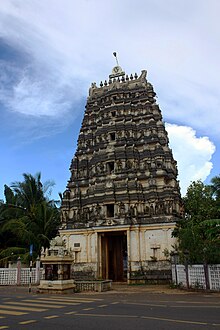Maviddapuram Kandaswamy Temple
| Maviddapuram Kandaswamy Temple | |
|---|---|
மாவிட்டபுரம் கந்தசாமி கோவில் | |
 | |
| Religion | |
| Affiliation | Hinduism |
| District | Jaffna District |
| Deity | Murugan |
| Location | |
| Location | Maviddapuram |
| State | Northern Province |
| Country | Sri Lanka |
 Location within Northern Province | |
| Geographic coordinates | 09°48′04.00″N 80°02′06.20″E / 9.8011111°N 80.0350556°ECoordinates: 09°48′04.00″N 80°02′06.20″E / 9.8011111°N 80.0350556°E |
Maviddapuram Kandaswamy Temple (Tamil: மாவிட்டபுரம் கந்தசாமி கோவில்) is a Hindu temple in Maviddapuram in northern Sri Lanka.
History[]
According to legend Maviddapuram has had a Hindu shrine for 5,000 years.[1] According to another legend, an 8th-century Chola[a] princess Mathurapuraveeravalli,[b] daughter of Tissai Ughra Cholan, the King of Madurai, was inflicted with a persistent intestinal disorder as well as facial disfigurement which made her face look like a horse.[3][4][5] She was advised by a priest/sage to bathe in the freshwater spring at Keerimalai.[3][4] After bathing in the spring Mathurapuraveeravalli's illness and disfigurement vanished.[3][4] In gratitude she renovated a Hindu shrine, located in Kovil Kadavai about two kilometers south east of the spring, into a full temple honouring the Hindu god Murugan (Skanda).[3][4][5] The King of Madurai sent sculptors, artists, building material, granite, statues, gold, silver etc. to assist with the renovation.[3] The temple's statue of Kankesan (Murugan) was brought via the port of Gayathurai which was later renamed Kankesanthurai.[6][7]
The name Maviddapuram is derived from ma (horse), vidda (removed) and puram (holy city).[3] The temple was destroyed and rebuilt several times.[1] The present day temple dates from the 17th century.[8]
Only "high" caste Hindus had been allowed to worship in the temple.[9] In 1968 several hundred "low" caste Hindus, mainly Pallar and Nalavar, staged a non-violent protest outside the temple gates but were met with violence from a group of "high" caste Hindus.[10] In June 1968 "low" caste Hindus stormed the temple.[11] They were given access to the temple following the intervention of Illankai Tamil Arasu Kachchi (ITAK, Federal Party).[12] C. Suntharalingam, who had led the "high" caste resistance to opening the temple up to the "low" castes, was prosecuted under the and fined Rs. 50 by the Supreme Court.[13] This act, which had been brought in as a private member's bill by ITAK in 1957, made the denial of entry into a place of worship on grounds of caste an offence.[12][13]
During the early 1990s the northern part of the Valikamam region were declared a High Security Zone (HSZ) and all the residents expelled.[14][15] The temple was inside the HSZ and as a result its priests were evicted by the military.[8][16] The temple's structure was bombed and its contents looted.[8] Following the end of the civil war the military relaxed some restrictions on entering the HSZ, allowing priests and worshipers to return to the temple.[8] The temple's 108 foot gopuram has been re-built but much of the 17th century temple was destroyed during the civil war.[8]
The temple was declared an archaeological protected monument in December 2011.[17]
Notes[]
References[]
- ^ a b Dissanayake, Daya (30 November 2011). "Temple carvings in Jaffna". Daily News (Sri Lanka).
- ^ The Rough Guide to Sri Lanka. Rough Guides.
- ^ a b c d e f Yatawara, Dhaneshi Yatawara (17 August 2008). "Festival of devotional splendour". Sunday Observer (Sri Lanka).
- ^ a b c d Wijesinghe, W. A. M. (28 November 2010). "The rich colours of Hinduism". The Nation (Sri Lanka).
- ^ a b David, Kenneth (1977). "Hierarchy and Equivalence in Jaffna North Sri Lanka: Normative Codes as Mediator". In David, Kenneth (ed.). The New Wind: Changing Identities in South Asia. De Gruyter Mouton. p. 185. ISBN 90-279-7959-6.
- ^ Yatawara, Dhaneshi (1 September 2013). "Surge of devotion reverberates the North". Sunday Observer (Sri Lanka). Archived from the original on 5 April 2016. Retrieved 26 March 2016.
- ^ "Maviddapuram Kandaswamy Kovil". Time Out.
- ^ a b c d e Karafin, Amy (15 March 2013). "Sri Lanka, as It Heals From War". The New York Times.
- ^ Welhengama, Gnanapala; Pillay, Nirmala (2014). The Rise of Tamil Separatism in Sri Lanka: From Communalism to Secession. Routledge. p. 211.
- ^ Wickramasinghe, Nira (2014). Sri Lanka in the Modern Age: A History. Oxford University Press. p. 289. ISBN 978-0-415-85486-3.
- ^ Jayaweera, Neville (23 January 2011). "Without 1956 and 1983 as triggers – would the Tamil uprising have occurred anyway?". The Island (Sri Lanka).
- ^ a b Hoole, Ratnajeevan (14 July 2013). "Jaffna's Upcoming Elections: Caste Ramifications". The Sunday Leader.
- ^ a b Jayaweera, Neville (16 November 2008). "The wretched of the earth". The Island (Sri Lanka).
- ^ Jeyaraj, D. B. S. (18 January 2003). "High-stakes zones". Frontline. 20 (2).
- ^ "Asia Report No. 220 - Sri Lanka's North II: Rebuilding under the Military" (PDF). International Crisis Group. 16 March 2012. p. 21. Archived from the original (PDF) on 14 August 2013.
- ^ Jansz, Frederica (5 January 2003). "HSZs rock peace process". The Sunday Leader.
- ^ "PART I : SECTION (I) — GENERAL Government Notifications" (PDF). The Gazette of the Democratic Socialist Republic of Sri Lanka. 1739: 1093. 30 December 2011. Archived from the original (PDF) on 9 April 2014. Retrieved 26 March 2016.
External links[]
 Media related to Mavidapuram Kandasamy temple at Wikimedia Commons
Media related to Mavidapuram Kandasamy temple at Wikimedia Commons
- Hindu temples in Jaffna District
- Murugan temples in Sri Lanka
- Archaeological protected monuments in Jaffna District
- Chola architecture

